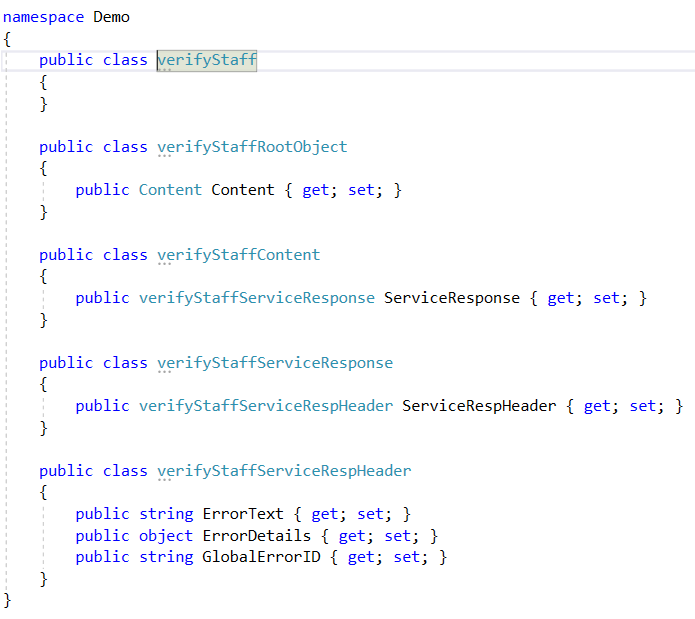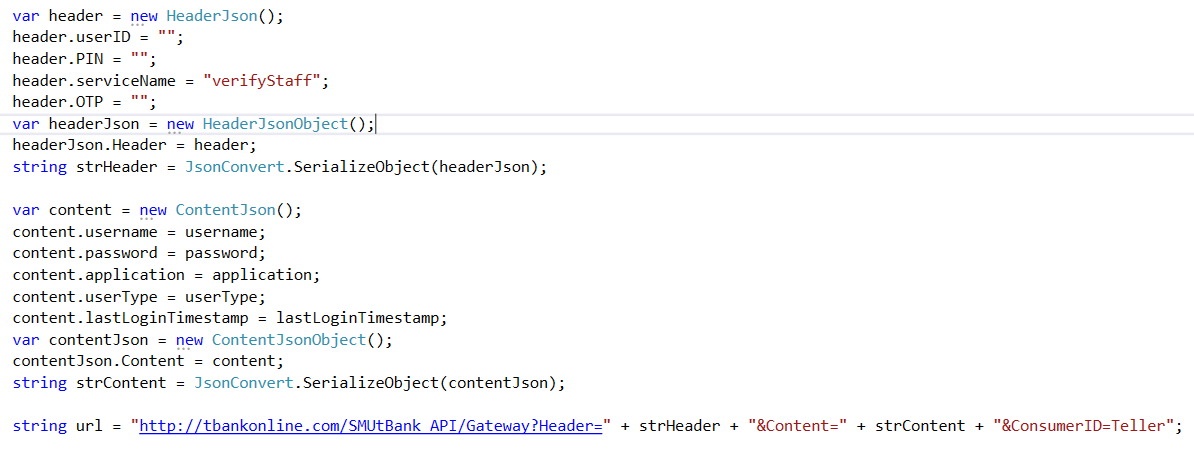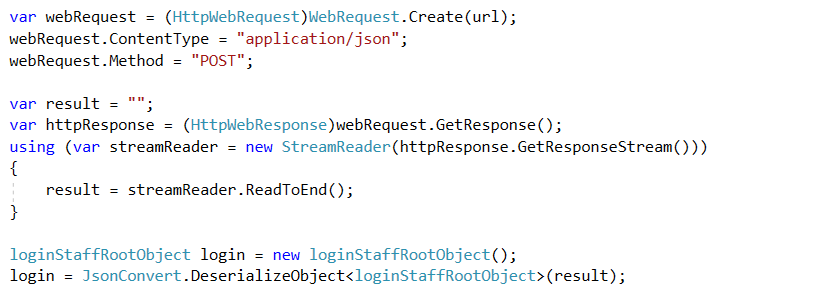Verify Staff
1.verifyStaff.cs
These four packages are required to be used.

Step 1. Create class file to store content of the web response.

2.verifyStaff.aspx.cs
These 13 packages are required to be used.

Step 1. Store Details which entered by the user.

Step 2. Create URL which will be post to the server. User inputs need to be stored in the class created, and serialize into JSON format. In this function, both header and content is needed.

Step 3. Post to the server, and store response. URL is sent using web request function, and a response will be send back from the server. The response need to be deserialized into the ‘verifyStaff’ class.

Step 4. Obtain error code. If error code is ‘010000’ which means invocation successful, populate attributes of the ‘verifyStaff’ class into the Label. Else, we will display the ErrorText and ErrorDetails.

Overview of verifyStaff.cs
using System;
using System.Collections.Generic;
using System.Linq;
using System.Web;
namespace Demo
{
public class verifyStaff
{
}
public class verifyStaffRootObject
{
public Content Content { get; set; }
}
public class verifyStaffContent
{
public verifyStaffServiceResponse ServiceResponse { get; set; }
}
public class verifyStaffServiceResponse
{
public verifyStaffServiceRespHeader ServiceRespHeader { get; set; }
}
public class verifyStaffServiceRespHeader
{
public string ErrorText { get; set; }
public object ErrorDetails { get; set; }
public string GlobalErrorID { get; set; }
}
}
Overview of verifyStaff.aspx.cs
using System;
using System.Collections.Generic;
using System.Linq;
using System.Web;
using System.Web.UI;
using System.Web.UI.WebControls;
using DotNetOpenAuth.OAuth2;
using Newtonsoft.Json;
using System.Collections.Specialized;
using System.Configuration;
using System.Net;
using System.IO;
using System.Windows.Forms;
namespace Demo
{
public partial class VerifyStaff : System.Web.UI.Page
{
protected void Page_Load(object sender, EventArgs e)
{
}
protected void btnSend_Click(object sender, EventArgs e)
{
if (Page.IsValid)
{
try
{
string username = txtusername.Text;
string password = txtpassword.Text;
string application = txtapplication.Text;
string userType = txtuserType.Text;
string lastLoginTimestamp = txtlastLoginTimestamp.Text;
var header = new HeaderJson();
header.userID = "";
header.PIN = "";
header.serviceName = "verifyStaff";
header.OTP = "";
var headerJson = new HeaderJsonObject();
headerJson.Header = header;
string strHeader = JsonConvert.SerializeObject(headerJson);
var content = new ContentJson();
content.username = username;
content.password = password;
content.application = application;
content.userType = userType;
content.lastLoginTimestamp = lastLoginTimestamp;
var contentJson = new ContentJsonObject();
contentJson.Content = content;
string strContent = JsonConvert.SerializeObject(contentJson);
string url = "http://tbankonline.com/SMUtBank_API/Gateway?Header=" + strHeader + "&Content=" + strContent + "&ConsumerID=Teller";
var webRequest = (HttpWebRequest)WebRequest.Create(url);
webRequest.ContentType = "application/json";
webRequest.Method = "POST";
var result = "";
var httpResponse = (HttpWebResponse)webRequest.GetResponse();
using (var streamReader = new StreamReader(httpResponse.GetResponseStream()))
{
result = streamReader.ReadToEnd();
}
loginStaffRootObject login = new loginStaffRootObject();
login = JsonConvert.DeserializeObject<loginStaffRootObject>(result);
string globalErrorID = login.Content.ServiceResponse.ServiceRespHeader.GlobalErrorID.ToString();
if (globalErrorID == "010000")
{
lblStatus.Text = "Staff Verified";
}
else
{
lblTest.Text = login.Content.ServiceResponse.ServiceRespHeader.ErrorText.ToString();
string errorMessage = login.Content.ServiceResponse.ServiceRespHeader.ErrorDetails.ToString();
lblErrorMessage.Text = errorMessage;
}
}
catch (Exception ex)
{
lblExceptionMsg.Text = ex.ToString();
}
}
}
}
}
Created with the Personal Edition of HelpNDoc: Easily create EBooks